|
|
 Renault Renault
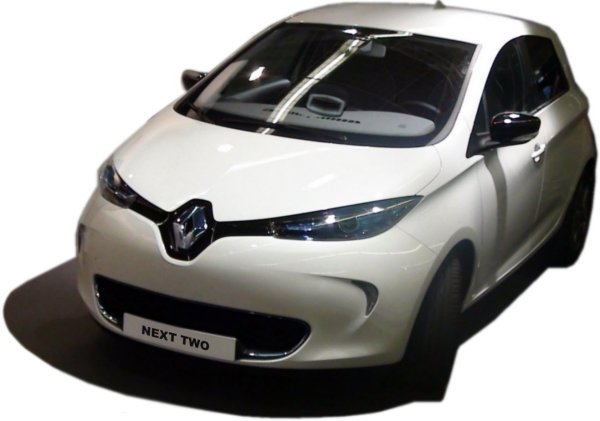
Relatively inconspicuous like the Renault Zoe itself, the NEXT TWO from 2014 appears as the first in a series of vehicles that will be presented in at least three truly autonomously driving prototypes in 2018. After all, this
manufacturer enables us to go through the development chain right up to the self-driving car.
How they managed to let the last three drive without a steering wheel, at least in the video, remains the company's secret. In any case, they started with a small fleet of the type shown above, which was already able to keep
its lane and its distance to the vehicle in front without hands on the wheel in association with the others.
The latter was made possible by the radar sensor in the center of the front bumper. Cameras behind the windshield provided a more lateral view, e.g. also on lane markings. There was probably already a rear one in the Zoe
series. The 'view' of ultrasonic sensors is shorter, but they are so small that they can be distributed around the car.
The sensors described so far, together with electronic-accelerator pedal, result in an adaptive cruise control. In addition, a type of superimposed steering or its electrical support and brake-by-wire are required. Of course, the
most important part is still missing, the control, where all the threads or cables come together, as well as a possibility of activation on the steering wheel or dashboard.
The head-up display is actually superfluous for automated driving, because you need less rather than more information for the driver, if still available at all. However, navigation is very important for this, and it is ensured that it
is up-to-date by a smartphone and/or multi-band antenna. It is still a very limited autonomous driving, only allowed on main roads with no pedestrians and cyclists and up to 30 km/h.
If no people (and animals) move freely in the parking garage, you can leave the NEXT TWO at the entrance and it will look for a place on its own. It then comes back via smartphone call. Despite the relatively short phases of
really autonomous driving, possible substitute actions by the driver have already been contemplated and partially implemented, e.g. the mobile office with broadband connectivity.
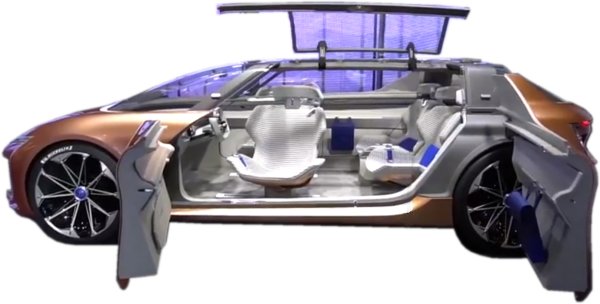
Renault Symbioz 550 Nm, 2 motors, a total of 550 kW (680 CV), 72 kWh, rear wheel drive, 4,9/3,1/1,9/1,4 m, WiFi, 4G, GPS, 2017
The Renault Symbioz is not only purely electrically powered, like the Zoe, but is also fully networked. That's why he doesn't have to stop at toll stations, at least at a few French ones. Although his Car2Car can probably only
refer to similar vehicles from the group. It is classified as Level 4, although the front seats can be swiveled away from the steering wheel. The glass dome is probably a reminiscence of the American experiments from 1960.
However, despite the high level, it is emphasized that, in addition to overtaking, the vehicle can also 'take corners'. Not only the opening of the doors and the transparent roof differ significantly from the NEXT TWO. A lot is also
done inside to create a special feel-good atmosphere. In addition to the two modes 'Classic' and 'Dynamic', there is also the Autonomous Driving. In the latter, the steering wheel and pedals move back
twelve centimeters. The headlights are obviously no longer needed. They now emit blue light.
In addition to the normal arrangement of the seats and the arrangement of all four to each other, only the two front seats can be rotated by 15° to each other. Also famous is the picture where a driver does not turn to the
passenger, but beams into other worlds with virtual reality glasses. Lidar is now used as the sensor technology. Radar, ultrasound and cameras remain and ensure more security through multiple redundancies
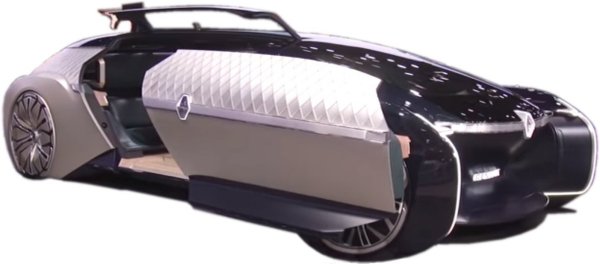
Renault EZ-ULTIMO 550 Nm, 1 motor, charging by induction, rear wheel drive, 5,7/3,88/2,2/1,35 m, 1.800 kg curb weight, 2018
The Renault EZ-ULTIMO was unveiled at the 2018 Paris Motor Show. It's a self-driving car for rich people. There is neither a steering wheel, nor pedals, nor a place for a driver. Although of a stately size, it only has room for
three people. It can be booked for a luxurious ride. So to speak you ride in an armchair in the living room with all the comforts, all-round shelves with an integrated table and walnut floor seem to be a matter of course.
Nevertheless, the car is not intended for long journeys, but rather to exclusive restaurants or the theatre. The 600 small diamond-shaped windows act like one-way mirrors. The lower part of the door slides in front of the front
wheel when opened, the upper part is similar to that of the Symbioz. The armchair comes near to accommodate a passenger. However, the roof is multiple divided by heavy beams.
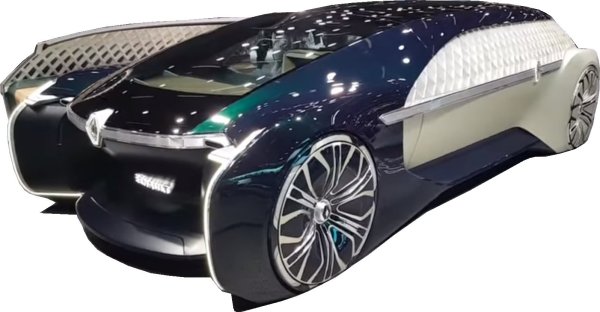
At the front, the floor can be folded down if necessary and the complete battery pack is offered for a possible change. For easier manoeuvring, the vehicle, which is at least 5.6 meters long, also steers with the rear axle.
Renault depicts him almost exclusively in the city, preferably driving up before hotels. From an aerodynamic point of view, it would not be bad with its shape even for longer distances.
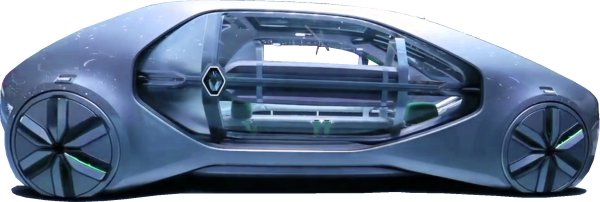
Renault EZ-GO 550 Nm, 1 motor, rear wheel drive, 5,2/3,8/2,2/1,6 m, 1700/300 kg total/battery weight, 2018
The Renault EZ-GO, a robot taxi for the city, is significantly less comfortable. It was presented in 2018, namely at the Geneva Motor Show. Up to six people sit on benches arranged in a U-shape, mostly with their backs to the
windows. The real gag of this vehicle is the entrance. To do this, the entire roof opens and a ramp extends at the front, which with a little help can even be mastered by wheelchair users.
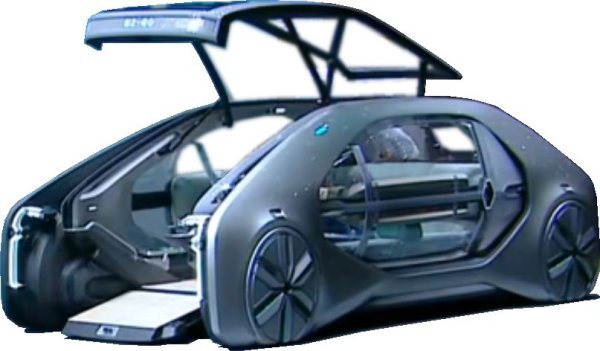
This works better on ramps that are approached forwards. The sensors are the same as before, but the top speed is limited to 50 km/h. For pedestrians, the EZ-GO makes itself noticeable through both noise and a light
signature. The rear axle is driven, again in a self-steering configuration.
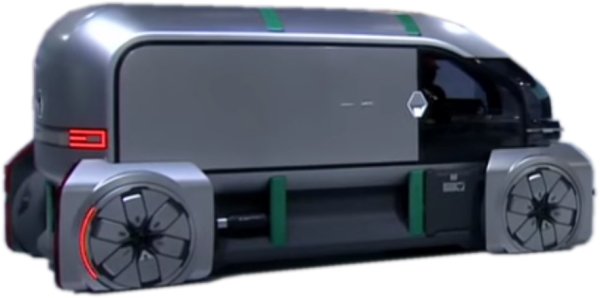
Renault EZ-PRO 550 Nm, 1 motor, rear wheel drive, 4,8/3,9/2,1/2,2 m, 6,0/12,0* m2, 1.000/2.000* kg payload, 2.500/2.800* kg total weight, 2018, *Leader-/Follower
Renault also thought about the so-called 'last mile' at the Commercial Vehicle IAA 2018 in Hanover. This is probably the most complicated part of sending parcels. Here it becomes completely clear that you need your own
routes for autonomously driving cars. Because there is a 'trailer' for the vehicle shown above, which looks the same at the front and at the back and is only coupled virtually.
This creates a convoy in the truest sense of the word, because the trailer becomes a 'follower', i.e. follows the vehicles in front of it at a short distance at every turn. However, it can also separate if it has to travel to different
destinations than its predecessors. Another special feature is the fact that there is a chassis on which various modules can be placed relatively easily.
So if the side panels should be hinged because the vehicle is being utilized for sales purposes, the upper part can be changed. Something similar has already been seen at Mercedes. The structure is usually so cubic that
there is space for solar collectors. Various accesses are possible, e.g. also from the front through a hinged window/roof construction. Special features are the accommodation of all sensors in the wheel spats, as well as the
charging of the battery by induction.
You can already see the target course. Unaccompanied transport to companies should be less of a problem than to private individuals. In addition there would be some sort of locker system. Then a pick-up time will be
agreed while the EZ-PRO is in front of the house. If the package is not picked up, an electronic notification is sent, similar to a note in the mailbox today, if nobody was at home.

kfz-tech.de/YAu4

kfz-tech.de/YAu5

kfz-tech.de/YAu6
|
|